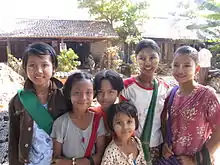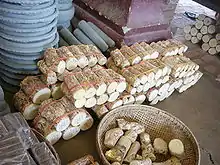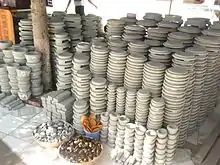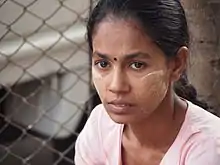Thanakha
Thanakha (Burmese: သနပ်ခါး; MLCTS: sa. nap hka:; pronounced [θənəkʰá]) is a paste made from ground bark. It is a distinctive feature of the culture of Myanmar, seen commonly applied to the face and sometimes the arms of women and girls, and is used to a lesser extent also by men and boys.[1][2][3]

History
The earliest literary reference to thanakha is in a 14th-century poem written by King Razadarit's Mon-speaking consort.[4] Mentions of thanakha also exist in the 15th-century literary works of Burmese monk-poet Shin Raṭṭhasāra (1486-1529).[4]
Source and preparation


The wood of several trees may be used to produce thanakha cream; these trees grow abundantly in central Myanmar. They include principally Murraya spp. (thanakha) [2] but also Limonia acidissima (theethee or wood apple).[5] The two most popular are Shwebo thanakha from Sagaing Region and Shinmadaung thanakha from Magway Region. A more recent contender sold as a paste is Taunggyi Maukme thanakha from southern Shan State. Thanakha trees are perennials, and a tree must be at least 35 years old before it is considered mature enough to yield good-quality cuttings. Thanakha in its natural state is sold as small logs individually or in bundles, but nowadays also available as a paste or in powder form.
Thanakha cream is made by grinding the bark, wood, or roots[2] of a thanakha tree with a small amount of water[5] on a circular slate slab called kyauk pyin,[6] which has a channel around the rim for the water to drain into.
Application, style and properties
Thanakha cream has been used by Burmese men, women, and children ( especially women as make-up )for over 2,000 years.[6] It has a fragrant scent somewhat similar to sandalwood.[2][7] The creamy paste is applied to the face in attractive designs, the most common form being a circular patch on each cheek, nose, sometimes made stripey with the fingers known as thanakha bè gya, or patterned in the shape of a leaf, often also highlighting the bridge of the nose with it at the same time.[6] It may be applied from head to toe (thanakha chi zoun gaung zoun). Apart from cosmetic beauty, thanakha also gives a cooling sensation and provides protection from sunburn.[1] It is believed to help remove acne and promote smooth skin.[6] It is also an anti-fungal.[2] The active ingredients of thanakha are coumarin and marmesin.[8]
 Market stall keeper wearing thanakha, Mandalay
Market stall keeper wearing thanakha, Mandalay Market children with thanakha, Mandalay
Market children with thanakha, Mandalay Thanakha seller at Kaunghmudaw Pagoda, Sagaing
Thanakha seller at Kaunghmudaw Pagoda, Sagaing A Karen child (an ethnic group in Burma and Thailand) with Thanakha on her face.
A Karen child (an ethnic group in Burma and Thailand) with Thanakha on her face. A Burmese Hindu woman wearing Thanakha.
A Burmese Hindu woman wearing Thanakha. A girl wearing Thanakha in Yangon.
A girl wearing Thanakha in Yangon.
See also
| Wikimedia Commons has media related to Thanaka. |
Notes
- Streissguth, Thomas (2007). Myanmar in Pictures. Twenty-First Century. pp. 44, 73. ISBN 0-8225-7146-3. Retrieved 2008-01-21.
- Mabberley, D J (1997). The Plant-Book: A Portable Dictionary of the Vascular Plants. Cambridge University Press. pp. 470. ISBN 0-521-41421-0. Retrieved 2008-01-21.
- Kemp, Charles & Lance Andrew Rasbridge (2004). Refugee and Immigrant Health: A Handbook for Health Professionals. Cambridge University Press. p. 98. ISBN 0-521-53560-3. Retrieved 2008-01-21.
- Yeni (5 August 2011). "Beauty That's More Than Skin Deep". The Irrawaddy. Archived from the original on 6 August 2011. Retrieved 7 August 2011.
- Köllner, Helmut & Axel Bruns (1998). Myanmar (Burma). Hunter Publishing. p. 18. ISBN 3-88618-415-3. Retrieved 2008-01-21.
- Moe, J. "Thanakha withstands the tests of time". Mizzima News, 17 September 2008. Archived from the original on 20 September 2008. Retrieved 2008-12-06.
- Baker, William & Ira Bruce Nadel (2004). Redefining the Modern. Fairleigh Dickinson University Press. p. 24. ISBN 0-8386-4013-3. Retrieved 2008-01-21.
- "Archived copy". Archived from the original on 2013-12-11. Retrieved 2014-10-19.CS1 maint: archived copy as title (link)